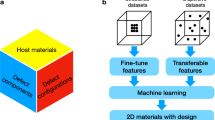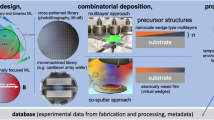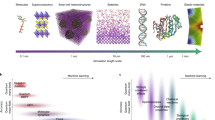Abstract
Harnessing big data, deep data, and smart data from state-of-the-art imaging might accelerate the design and realization of advanced functional materials. Here we discuss new opportunities in materials design enabled by the availability of big data in imaging and data analytics approaches, including their limitations, in material systems of practical interest. We specifically focus on how these tools might help realize new discoveries in a timely manner. Such methodologies are particularly appropriate to explore in light of continued improvements in atomistic imaging, modelling and data analytics methods.
This is a preview of subscription content, access via your institution
Access options
Subscribe to this journal
Receive 12 print issues and online access
$259.00 per year
only $21.58 per issue
Buy this article
- Purchase on Springer Link
- Instant access to full article PDF
Prices may be subject to local taxes which are calculated during checkout




Similar content being viewed by others
References
Hoddeson, M. R. a. L. Crystal Fire: The Invention of the Transistor and the Birth of the Information Age (W. W. Norton & Company, 1998).
Sze, S. M. Physics of Semiconductor Devices 2nd edn (Wiley-Interscience, 1981).
Shockley, W. Electrons and Holes in Semiconductors: With Applications to Transistor Electronics (D. Van Nostrand, 1950).
Fuechsle, M. et al. A single-atom transistor. Nature Nanotech. 7, 242–246 (2012).
Woodward, D. I., Knudsen, J. & Reaney, I. M. Review of crystal and domain structures in the PbZrxTi1–xO3 solid solution. Phys. Rev. B 72, 104110 (2005).
Vugmeister, B. E. Polarization dynamics and formation of polar nanoregions in relaxor ferroelectrics. Phys. Rev. B 73, 174117 (2006).
Fiebig, M. Revival of the magnetoelectric effect. J. Phys. D 38, R123–R152 (2005).
Binder, K. & Young, A. P. Spin-glasses—experimental facts, theoretical concepts, and open questions. Rev. Mod. Phys. 58, 801–976 (1986).
Dagotto, E. Complexity in strongly correlated electronic systems. Science 309, 257–262 (2005).
Dagotto, E., Hotta, T. & Moreo, A. Colossal magnetoresistant materials: The key role of phase separation. Phys. Rep. 344, 1–153 (2001).
Spaldin, N. A. & Fiebig, M. The renaissance of magnetoelectric multiferroics. Science 309, 391–392 (2005).
Adler, S. B. Factors governing oxygen reduction in solid oxide fuel cell cathodes. Chem. Rev. 104, 4791–4843 (2004).
Fischer, C. C., Tibbetts, K. J., Morgan, D. & Ceder, G. Predicting crystal structure by merging data mining with quantum mechanics. Nature Mater. 5, 641–646 (2006).
Curtarolo, S. et al. The high-throughput highway to computational materials design. Nature Mater. 12, 191–201 (2013).
Crewe, A. V. Scanning electron microscopes—is high resolution possible. Science 154, 729–738 (1966).
Pennycook, S. J. & Nellist, P. D. (eds) Scanning Transmission Electron Microscopy: Imaging and Analysis (Springer, 2011).
Ardenne, M. v. Das elektronen-rastermikroskop. Praktische Ausführung. Z. Tech. Phys. 19, 407–416 (1938).
Binnig, G., Rohrer, H., Gerber, C. & Weibel, E. 7 × 7 reconstruction on Si(111) resolved in real space. Phys. Rev. Lett. 50, 120–123 (1983).
Binnig, G. & Rohrer, H. Scanning tunneling microscopy. Helv. Phys. Acta 55, 726–735 (1982).
Gerber, C. & Lang, H. P. How the doors to the nanoworld were opened. Nature Nanotech. 1, 3–5 (2006).
Pennycook, S. J. & Kalinin, S. V. Microscopy: Hasten high resolution. Nature 515, 487–488 (2014).
Van Tendeloo, G., Bals, S., Van Aert, S., Verbeeck, J. & Van Dyck, D. Advanced electron microscopy for advanced materials. Adv. Mater. 24, 5655–5675 (2012).
Yankovich, A. B. et al. Picometre-precision analysis of scanning transmission electron microscopy images of platinum nanocatalysts. Nature Commun. 5, 4155 (2014).
Jia, C. L. et al. Atomic-scale study of electric dipoles near charged and uncharged domain walls in ferroelectric films. Nature Mater. 7, 57–61 (2008).
Chang, H. J. et al. Atomically resolved mapping of polarization and electric fields across ferroelectric/oxide interfaces by Z-contrast imaging. Adv. Mater. 23, 2474–2479 (2011).
Nelson, C. T. et al. Spontaneous vortex nanodomain arrays at ferroelectric heterointerfaces. Nano Lett. 11, 828–834 (2011).
Chisholm, M. F., Luo, W. D., Oxley, M. P., Pantelides, S. T. & Lee, H. N. Atomic-scale compensation phenomena at polar interfaces. Phys. Rev. Lett. 105, 197602 (2010).
Borisevich, A. et al. Mapping octahedral tilts and polarization across a domain wall in BiFeO3 from Z-contrast scanning transmission electron microscopy image atomic column shape analysis. ACS Nano 4, 6071–6079 (2010).
Jia, C. L. et al. Oxygen octahedron reconstruction in the SrTiO3/LaAlO3 heterointerfaces investigated using aberration-corrected ultrahigh-resolution transmission electron microscopy. Phys. Rev. B 79, 081405 (2009).
Kim, Y. M. et al. Probing oxygen vacancy concentration and homogeneity in solid-oxide fuel-cell cathode materials on the subunit-cell level. Nature Mater. 11, 888–894 (2012).
Van Aert, S., Van Dyck, D. & den Dekker, A. J. Resolution of coherent and incoherent imaging systems reconsidered—Classical criteria and a statistical alternative. Opt. Express 14, 3830–3839 (2006).
Van Aert, S., den Dekker, A. J., Van Dyck, D. & van den Bos, A. High-resolution electron microscopy and electron tomography: Resolution versus precision. J. Struct. Biol. 138, 21–33 (2002).
Pan, S. H. et al. Imaging the effects of individual zinc impurity atoms on superconductivity in Bi2Sr2CaCu2O8+δ . Nature 403, 746–750 (2000).
Roushan, P. et al. Topological surface states protected from backscattering by chiral spin texture. Nature 460, 1106–1109 (2009).
Lin, J. H. et al. Flexible metallic nanowires with self-adaptive contacts to semiconducting transition-metal dichalcogenide monolayers. Nature Nanotech. 9, 436–442 (2014).
Ishikawa, R. et al. Direct observation of dopant atom diffusion in a bulk semiconductor crystal enhanced by a large size mismatch. Phys. Rev. Lett. 113, 155501 (2014).
Huang, P. Y. et al. Imaging atomic rearrangements in two-dimensional silica glass: Watching silica's dance. Science 342, 224–227 (2013).
Zheng, H. M. et al. Observation of transient structural-transformation dynamics in a Cu2S nanorod. Science 333, 206–209 (2011).
Eigler, D. M. & Schweizer, E. K. Positioning single atoms with a scanning tunnelling microscope. Nature 344, 524–526 (1990).
Garcia, R., Knoll, A. W. & Riedo, E. Advanced scanning probe lithography. Nature Nanotech. 9, 577–587 (2014).
Balke, N., Bdikin, I., Kalinin, S. V. & Kholkin, A. L. Electromechanical imaging and spectroscopy of ferroelectric and piezoelectric materials: State of the art and prospects for the future. J. Am. Ceram. Soc. 92, 1629–1647 (2009).
Runkler, T. A. Data Analytics: Models and Algorithms for Intelligent Data Analysis (Vieweg, 2012).
Bonnet, N. in Advances in Imaging and Electron Physics Vol. 114 (ed. P. W. Hawkes) 1–77 (Elsevier Academic Press, 2000).
Hastie, T., Tibshirani, R. & Friedman, J. The Elements of Statistical Learning: Data Mining, Inference and Prediction 2nd edn (Springer, 2009).
Belianinov, A. et al. Big data and deep data in scanning and electron microscopies: Deriving functionality from multidimensional data sets. Adv. Struct. Chem. Imaging 1, 1–25 (2015).
Parr, R. G. & Weitao, Y. Density-Functional Theory of Atoms and Molecules (Oxford Univ. Press, 1994).
Sumpter, B. G. & Noid, D. W. On the design, analysis, and characterization of materials using computational neural networks. Annu. Rev. Mater. Sci. 26, 223–277 (1996).
Sumpter, B. G., Getino, C. & Noid, D. W. Theory and applications of neural computing in chemical science. Annu. Rev. Phys. Chem. 45, 439–481 (1994).
Phillips, J. C. & Rabe, K. M. Transport anomalies and internal structural models of stable quasi-crystals. Phys. Rev. Lett. 66, 923–925 (1991).
Villars, P., Phillips, J. C. & Chen, H. S. Icosahedral quasi-crystals and quantum structural diagrams. Phys. Rev. Lett. 57, 3085–3088 (1986).
Dongarra, J. et al. The International Exascale Software Project roadmap. Int. J. High Perform. Comput. Appl. 25, 3–60 (2011).
Materials Genome Initiative; http://go.nature.com/Rkw2mj
The Materials Project; https://www.materialsproject.org
Jain, A. et al. A high-throughput infrastructure for density functional theory calculations. Comput. Mater. Sci. 50, 2295–2310 (2011).
Jain, A. et al. Commentary: The Materials Project: A materials genome approach to accelerating materials innovation. APL Mater. 1, 011002 (2013).
Setyawan, W. & Curtarolo, S. High-throughput electronic band structure calculations: Challenges and tools. Comput. Mater. Sci. 49, 299–312 (2010).
Ramakrishnan, R., Dral, P. O., Rupp, M. & von Lilienfeld, O. A. Quantum chemistry structures and properties of 134 kilo molecules. Scientific Data 1, 140022 (2014).
Sohlberg, K., Rashkeev, S., Borisevich, A. Y., Pennycook, S. J. & Pantelides, S. T. Origin of anomalous Pt-Pt distances in the Pt/alumina catalytic system. ChemPhysChem 5, 1893–1897 (2004).
Bachelet, G. B. & Schluter, M. Relativistic norm-conserving pseudopotentials. Phys. Rev. B 25, 2103–2108 (1982).
von Lilienfeld, O. A., Tavernelli, I., Rothlisberger, U. & Sebastiani, D. Optimization of effective atom centered potentials for London dispersion forces in density functional theory. Phys. Rev. Lett. 93, 153004 (2004).
Baumeier, B., Kruger, P. & Pollmann, J. Self-interaction-corrected pseudopotentials for silicon carbide. Phys. Rev. B 73, 195205 (2006).
von Lilienfeld, O. A. & Schultz, P. A. Structure and band gaps of Ga-(V) semiconductors: The challenge of Ga pseudopotentials. Phys. Rev. B 77, 115202 (2008).
von Lilienfeld, O. A. Force correcting atom centred potentials for generalised gradient approximated density functional theory: Approaching hybrid functional accuracy for geometries and harmonic frequencies in small chlorofluorocarbons. Mol. Phys. 111, 2147–2153 (2013).
Zhou, F., Cococcioni, M., Marianetti, C. A., Morgan, D. & Ceder, G. First-principles prediction of redox potentials in transition-metal compounds with LDA + U. Phys. Rev. B 70, 235121 (2004).
Marzouk, Y. M., Najm, H. N. & Rahn, L. A. Stochastic spectral methods for efficient Bayesian solution of inverse problems. J. Comp. Phys. 224, 560–586 (2007).
Marzouk, Y. & Xiu, D. A stochastic collocation approach to Bayesian inference in inverse problems. Commun. Computational Phys. 6, 826–847 (2009).
Howson, C. & Urbach, P. Scientific Reasoning: The Bayesian Approach (Open Court, 2006).
Robert, C. The Bayesian Choice: From Decision-Theoretic Foundations to Computational Implementation (Springer Texts in Statistics) (Springer, 2001).
Lingerfelt, E. J., Messer, O. E. B., Desai, S. S., Holt, C. A. & Lentz, E. J. Near real-time data analysis of core-collapse supernova simulations with Bellerophon. Procedia Comput. Sci. 29, 1504–1514 (2014).
Rupp, M., Tkatchenko, A., Muller, K. R. & von Lilienfeld, O. A. Fast and accurate modeling of molecular atomization energies with machine learning. Phys. Rev. Lett. 108, 058301 (2012).
Montavon, G. et al. Machine learning of molecular electronic properties in chemical compound space. New J. Phys. 15, 095003 (2013).
Lopez-Bezanilla, A. & von Lilienfeld, O. A. Modeling electronic quantum transport with machine learning. Phys. Rev. B 89, 235411 (2014).
Ramakrishnan, R., Dral, P. O., Rupp, M. & Anatole von Lilienfeld, O. Big data meets quantum chemistry approximations: The Δ-machine learning approach. J. Chem Theory Comput. 11, 2087–2096 (2015).
Pyzer-Knapp, E. O., Suh, C., Gómez-Bombarelli, R., Aguilera-Iparraguirre, J. & Aspuru-Guzik, A. What is high throughput virtual screening? A perspective from organic materials discovery. Annu. Rev. Mater. Sci. 45, 195–216 (2015).
Hachmann, J. et al. Lead candidates for high-performance organic photovoltaics from high-throughput quantum chemistry—the Harvard Clean Energy Project. Energy Environ. Sci. 7, 698–704 (2014).
Bartok, A. P., Gillan, M. J., Manby, F. R. & Csanyi, G. Machine-learning approach for one- and two-body corrections to density functional theory: Applications to molecular and condensed water. Phys. Rev. B 88, 054104 (2013).
Machta, B. B., Chachra, R., Transtrum, M. K. & Sethna, J. P. Parameter space compression underlies emergent theories and predictive models. Science 342, 604–607 (2013).
Katsoulakis, M. A. & Plechac, P. Information-theoretic tools for parametrized coarse-graining of non-equilibrium extended systems. J. Chem. Phys. 139, 074115 (2013).
Materials Genome Initiative Strategic Plan; http://www.nist.gov/mgi/upload/MGI-StrategicPlan-2014.pdf
Spiegelhalter, D. The future lies in uncertainty. Science 345, 264–265 (2014).
Ovsjanikov, M., Bronstein, A. M., Bronstein, M. M. & Guibas, L. J. Shape Google: a computer vision approach to invariant shape retrieval. Proc. NORDIA 1, 1 (2009).
Zhu, J., Ferguson, D. I. & Dolgov, D. A. System and method for predicting behaviors of detected objects. US patent 8660734 B2 (2014).
Tourassi, G. D., Vargas-Voracek, R., Catarious, D. M. & Floyd, C. E. Computer-assisted detection of mammographic masses: A template matching scheme based on mutual information. Med. Phys. 30, 2123–2130 (2003).
Scharcanski, J. & Celebi, M. E. (eds) Computer Vision Techniques for the Diagnosis of Skin Cancer (Springer, 2013).
Mody, C. C. M. Instrumental Community (The MIT Press, 2011).
Reed, J. W. et al. TF-ICF: A new term weighting scheme for clustering dynamic data streams. 5th Int. Conf. Machine Learning Appl. 258–263 (IEEE, 2006).
Bollen, J. et al. Clickstream data yields high-resolution maps of science. PLoS ONE 4, e4803 (2009).
Aiello, L. M., Schifanella, R. & State, B. Reading the source code of social ties. Preprint at http://arXiv.org/abs/1407.5547v1 (2014).
He, Q., Woo, J., Belianinov, A., Guliants, V. V. & Borisevich, A. Y. Better catalysts through microscopy: Mesoscale M1/M2 intergrowth in molybdenum-vanadium based complex oxide catalysts for propane ammoxidation. ACS Nano 9, 3470–3478 (2015).
Lin, W. Z. et al. Direct probe of interplay between local structure and superconductivity in FeTe0.55Se0.45 . ACS Nano 7, 2634–2641 (2013).
Tselev, A. et al. Oxygen control of atomic structure and physical properties of SrRuO3 surfaces. ACS Nano 7, 4403–4413 (2013).
Cruz-Silva, E. et al. Edge-edge interactions in stacked graphene nanoplatelets. ACS Nano 7, 2834–2841 (2013).
Romo-Herrera, J. M., Terrones, M., Terrones, H., Dag, S. & Meunier, V. Covalent 2D and 3D networks from 1D nanostructures: Designing new materials. Nano Lett. 7, 570–576 (2007).
Acknowledgements
The authors thank A. Borisevich, H. Christen, J. Morris, and D. Levy, as well as multiple colleagues at ORNL and elsewhere for valuable discussions. R.K.A. acknowledges The Compute and Data Environment (CADES) for continuous support. E. Strelcov and R. Vasudevan are gratefully acknowledged for help with figure preparation. Research was sponsored by the Laboratory Directed Research and Development Program of Oak Ridge National Laboratory, managed by UT-Battelle, LLC, for the US Department of Energy. A portion of this research was conducted at the Center for Nanophase Materials Sciences, which is a DOE Office of Science User Facility. The algorithmic aspects were sponsored by the applied mathematics program at the DOE and the computational aspects made use of the Oak Ridge Leadership Computing Facility, a DOE Office of Science User Facility at ORNL supported under contract no. DE-AC05-00OR22725.
Author information
Authors and Affiliations
Corresponding author
Ethics declarations
Competing interests
The authors declare no competing financial interests.
Rights and permissions
About this article
Cite this article
Kalinin, S., Sumpter, B. & Archibald, R. Big–deep–smart data in imaging for guiding materials design. Nature Mater 14, 973–980 (2015). https://doi.org/10.1038/nmat4395
Received:
Accepted:
Published:
Issue Date:
DOI: https://doi.org/10.1038/nmat4395
This article is cited by
-
Deep learning for tumor margin identification in electromagnetic imaging
Scientific Reports (2023)
-
High-throughput exploration of halide perovskite compositionally-graded films and degradation mechanisms
Communications Materials (2022)
-
Correlative image learning of chemo-mechanics in phase-transforming solids
Nature Materials (2022)
-
Human- and machine-centred designs of molecules and materials for sustainability and decarbonization
Nature Reviews Materials (2022)
-
Analytical methods for superresolution dislocation identification in dark-field X-ray microscopy
Journal of Materials Science (2022)



